Chinese food vs. Japanese food – the delicate cooking from “The Land of the Rising Sun” put against the explosive cuisine of “The Red Dragon”. For food lovers such as you and me, choosing a clear winner between these two is practically impossible.
Much as I’d love to have both of them as the winner, I’m not going to do that today. Instead, I’ll give you all the quintessential information, what there is to love (or not to love) about these two countries’ cooking, and some of the things that they have in common.
After that, maybe you can finally decide the outcome for this classic food matchup!
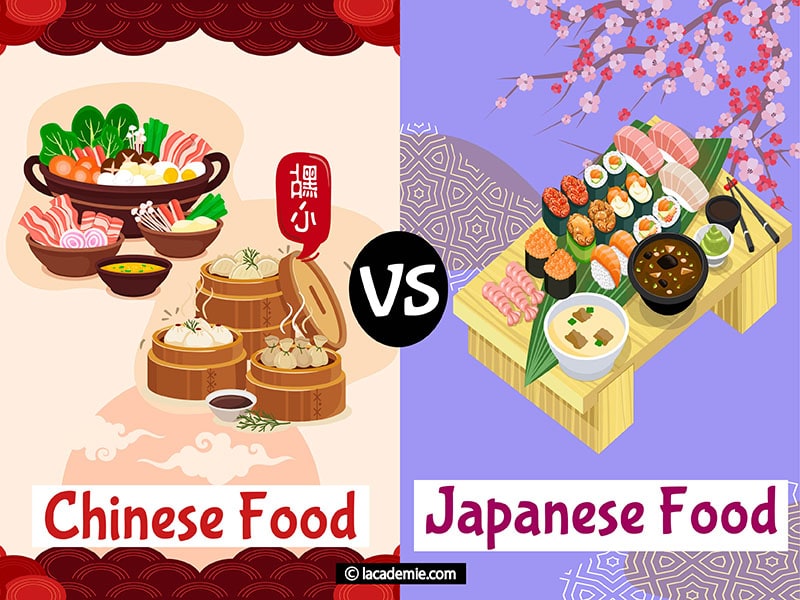
A Table To Summarize The Essentials
Before we start, here’s a quick table to summarize the key elements of iconic Chinese foods as well as Japanese dishes. Let’s have a look at the table below.
Chinese And Japanese Approach To Cooking
In an interview with Japanese chef Yukimura, Xiaosong Gao – a well-known Chinese TV presenter and producer, once asked Yukimura to describe the difference between Chinese and Japanese cooking in simple words.
In response to this question, chef Yukimura compared Japanese cooking to water, while Chinese cuisine is like fire. And to be honest, I can’t find a better answer myself.
For the seasoned foodies reading this, you’re probably nodding your head in agreement. However, for people that are less experienced in this topic, let me give you a more detailed explanation.
Japanese Food – The Gentle Flow Of Water
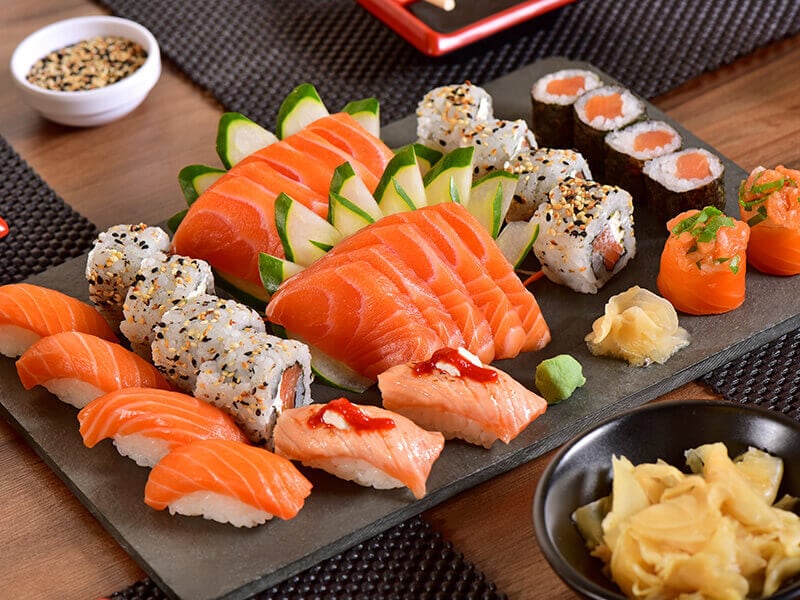
“Less is more” would be a suitable term to describe the Japanese view on cooking. Simply put, “keeping food true to its purest form as much as possible” is one of the most prioritized factors in Japanese cuisine.
This means that many Japanese traditional dishes might not require much cooking. A great example is sashimi – a dish made mainly of raw fish. Instead of blending the flavors of the ingredients together, the Japanese prefer to have each of them shine individually.
However, don’t mistake the Japanese’ minimal approach to cooking for laziness or uncreativity. The beauty of Japanese cuisine lies in the harmony and balance of each and every ingredient, along with the attention to detail in flavors, aesthetic and nutritional value.
“Wait, does that mean the Japanese only eat steamed, boiled, or raw food in order to retain the natural flavor?” – you might ask. Of course not! Japanese cuisine also includes a variety of broiled or fried dishes. More details on that later.
Chinese Food – The Fire Of The Dragon
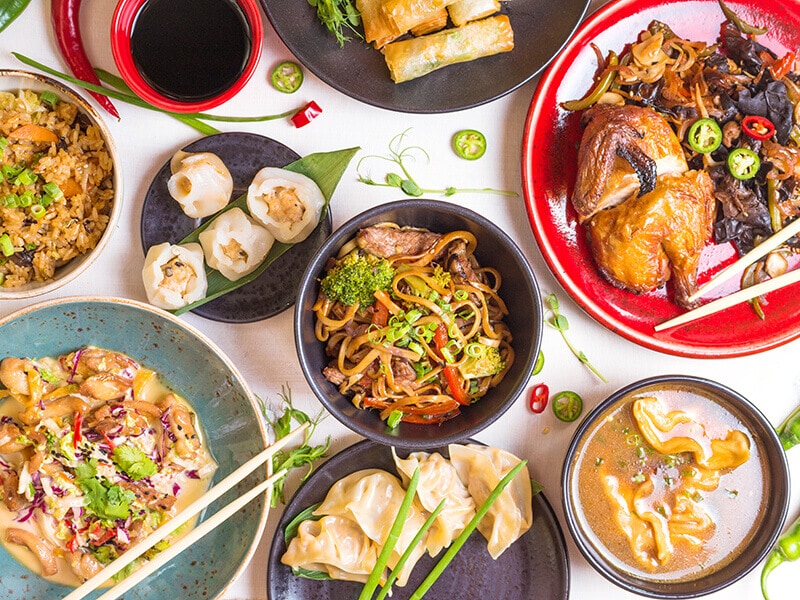
Generally speaking, while Japanese cuisine follows the idea of “minimalism”, “maximalism” is the heart and soul of Chinese cooking.
Color, aroma, and taste are three crucial factors of a good Chinese dish. Because of this, a Chinese banquet is always colorful, so aromatic that you can even smell the food from afar, and of course, packed full of explosive flavors.
To achieve this incredible feast, Chinese chefs have to master the art of choosing and flavoring the ingredients with suitable spices. They’re also experts in “playing with the heat” and filling the dishes with eye-catching colors.
Contrary to the idea of “preserving the original taste” of the Japanese, Chinese cooking focuses more on blending spices to create new, exciting tastes. This is why Chinese dishes often have more seasoning and, in a way, taste more flavorful than the Japanese ones.
How These Two Countries Use Rice And Noodle
Rice and noodles are two Asian cuisine staples. Let’s see how these two countries compare to each other when it comes to cooking them.
The Use Of Rice And Noodles In Japanese Cuisine
Like other Asian cuisines, Japanese cooking also makes good use of rice and noodles. In fact, many Japanese dishes won’t be complete without these two crucial ingredients.
When it comes to rice, the Japanese have a long list of “don” (short for donburi which means bowl) dishes that are the combination of rice and various meats served in a bowl. Gyudon (beef with rice), Oyakodon (chicken, egg with rice) are two popular examples.
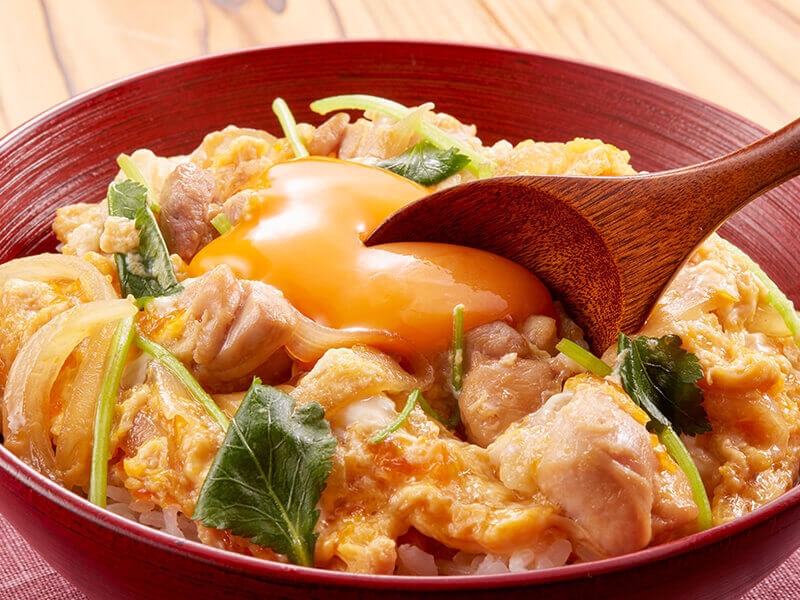
And there is also sushi – a classic staple for Japanese cuisine, in which rice plays an essential role. Although most people only concentrate on the freshness of the raw seafood, rice can actually make or break a dish of sushi.
As for authentic Japanese noodles, udon – thick wheat-based noodles, soba – buckwheat noodles, and somen – thin, white wheat flour noodles, are some of the most common ones.
Each has a unique taste, texture and is served with different types of broth and toppings.
Ramen is another famous type of noodle in Japan. However, if you look further into the origin of ramen, you will see that it’s actually imported into Japan from China and was once called “Chinese soba”. Additionally, ramen is used to make yakisoba (stir-fried noodles).
How Chinese People Make Use Of Rice And Noodles
Rice and noodles play an important part in Chinese cooking, though the way Chinese people make use of their rice is quite different from the Japanese.
Rice is often used as a base dish in Chinese cuisine. In addition to white, boiled rice that is widely seen in a family meal, rice can also be stir-fried in a wok.
Stir-fried rice can be paired with practically any ingredients, from vegetables to eggs to chicken, duck, or pork. Because of how versatile and crowd-pleasing stir-fried rice is, this dish can be found in every Chinese-styled restaurant.
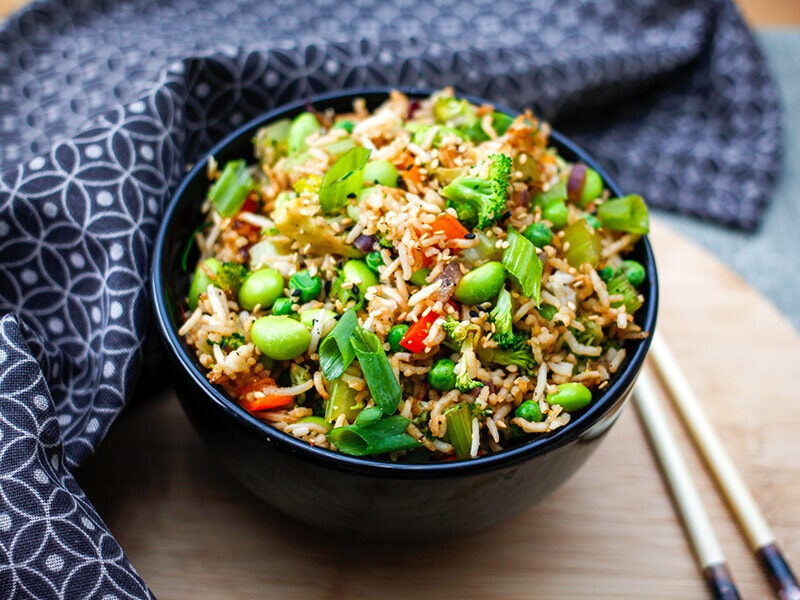
For noodles, lo mein and ramen are two of the more popular choices. Both of them can be stir-fried with vegetables and meat. In addition, ramen is also served in broth together with a combination of eggs (either soft boiled or fried), meat, and vegetables.
What About The Meat?
Eating meat is a great way to provide your body with much-needed protein. While Japanese people are undoubtedly avid seafood lovers, the Chinese are famous for their versatile meat choices.
In this section, let’s go into details on how these two countries integrate meat into their cooking.
Common Types Of Meat Used In Japanese Cooking
The Japanese aren’t shy to admit their love for seafood, and this love is reflected clearly in the country’s cuisine and many renowned Japanese cookbooks.
In addition to dishes with fresh, raw fishes like sushi or sashimi, Japan also has a bundle of delicious seafood recipes. Some of the more known ones are buri daikon – yellowtail fish simmered with daikon radish, sanma no nitsuke – braised mackerel pike.
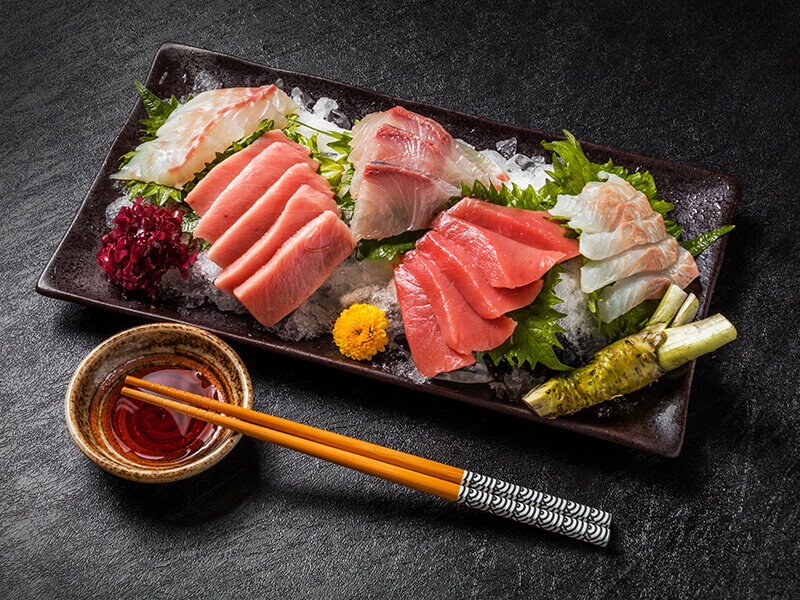
Besides seafood, pork, beef, and chicken are also widely used in Japanese cooking. They might be cooked in many different ways, but three of the most common ways are: simmer, grill, and deep-fry.
Although Japanese people tend to shy away from “exotic” types of meat, eel (or unagi in Japanese) is one of the few exceptions. They even have a day called Doyo no Ushi no Hi that is dedicated to eating eel!
Types Of Meat Used In Chinese Cooking
Compared to the more “conservative” meat choice of the Japanese, Chinese cuisine contains a much wider variety of meat types.
Apart from the conventional meat types such as pork, beef, chicken, duck, and fish, Chinese chefs can also turn more “exotic” animals into tasty meals.
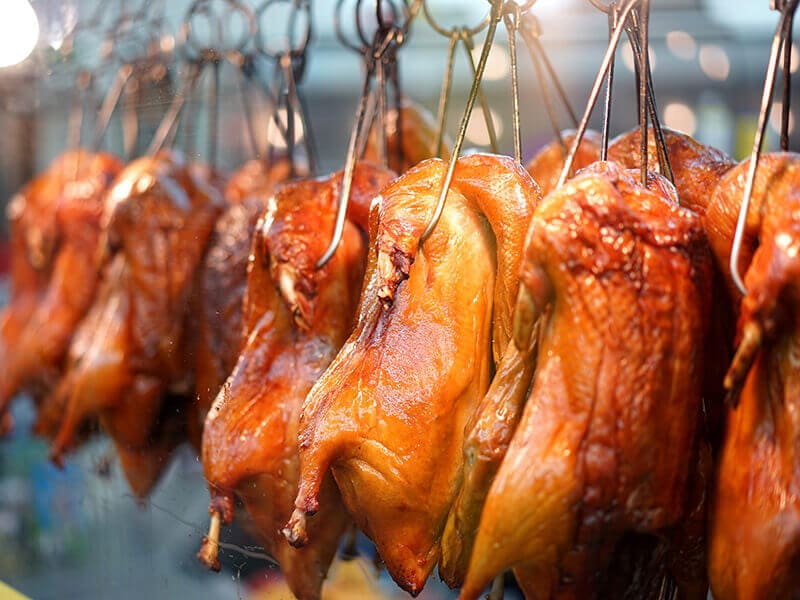
It’s hard to imagine animals like turtles, frogs, or snakes appearing in a traditional Japanese meal, though it’s not that uncommon to eat them in Chinese cuisine or see them in reputable Chinese cooking books.
That said, not everyone in China enjoys these kinds of meat, and most people would normally stick to the more conventional types.
It’s Also About The Cut
Japanese chefs take their knife skills really seriously. Every ingredient has to be cut “the way it’s meant to be”, especially in raw, fresh seafood dishes.
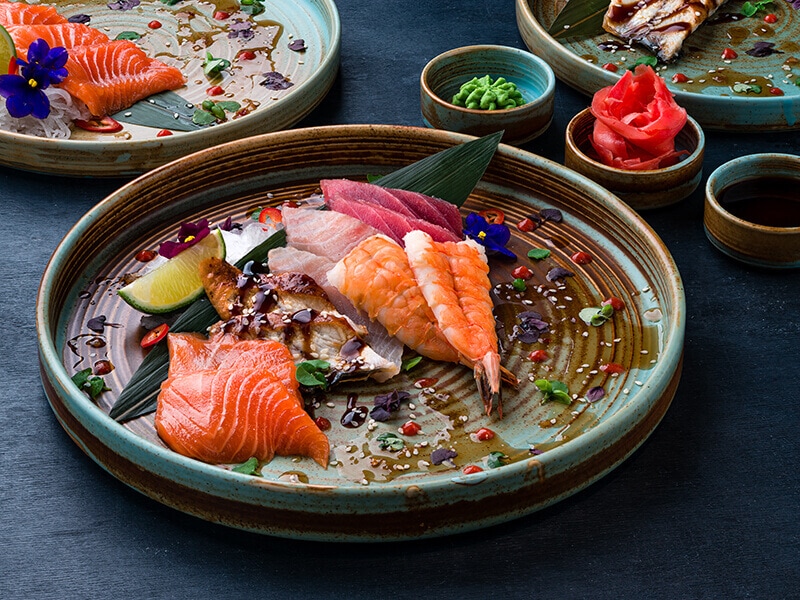
Typically, Japanese chefs have to spend years practicing and mastering their knife work to bring out the best in the ingredients’ natural flavor. They have a huge collection of knives, each of them meant to be used in specific situations. Some common examples are:
- The Santoku
The santoku is a straight, curvy edge knife with a sheepsfoot blade. This knife is the classic all-purpose knife that can be easily seen in a Japanese family’s kitchen.
- The Nakiri
The nakiri is shaped quite similar to a meat cleaver with a square tip and a thin, deep blade. It’s ideal for cutting vegetables in large quantities.
- The Yanagiba
This long, single-bevel knife is made to cut raw seafood and is a must-have for sushi chefs.
Learn more about the different types of Japanese knives and how they’re used. Watch this video:
On the contrary, Chinese cooking focuses more on quick, effective cuts. That’s why chunky, mouth-filling meat slices are often seen in Chinese cuisine. A chef’s knife and a Chinese meat cleaver with decent sharpness are more than enough to make an outstanding meal.
Cooking The Japanese And Chinese Way
As their ideas on cooking are vastly different, Japan and China will surely have different ways to cook their food. Before reading, try and guess how these two countries’ chefs handle their ingredients and see if you are right!
Cooking The Japanese Way
As mentioned earlier, Japanese people favor the natural flavor of ingredients rather than mixing and blending to create new ones. Because of this, fresh eating and cooking methods that involve the use of water, such as boiling, steaming, or stewing, are widely used.
For fried dishes, the Japanese usually prefer deep frying to stir-frying. This way, the food can attain a beautiful, golden color while retaining its original taste. One prime example of a Japanese fried dish would be the tempura – deep-fried seafood and vegetables.
Japanese people often use teppan – a standard iron flat pan, to pan-fry food at high temperatures. That said, they have taken this ordinary cookware to another level with teppanyaki-style restaurants.
In these restaurants, customers’ food will be cooked right in front of their eyes on a large teppan. Hot, freshly cooked food and a live cooking performance to entertain yourself while eating, what more could one ask for?
Grilling and broiling are commonly used in Japanese cuisine as well, with yakiniku (grilled meat) and yakitori (grilled chicken) being two of the more famous ones. Finally, Japanese people also enjoy nabe (hot pot) dishes, especially in the cold winter months.
How Chinese Food Is Cooked – Bring In The Heat!
Although raw, fresh eating is not a rare thing in Japanese cuisine, the Chinese much prefer their food to be cooked thoroughly. In other words, while Japanese chefs take pride in “retaining the original taste”, Chinese chefs are the master of “cooking in various ways”.
To create an explosive taste, Chinese chefs make great uses of herbs and spices in their cooking. In Chinese cooking, herbs like ginger, garlic, star anise, or cassia, for some quick examples, are considered the must-haves.
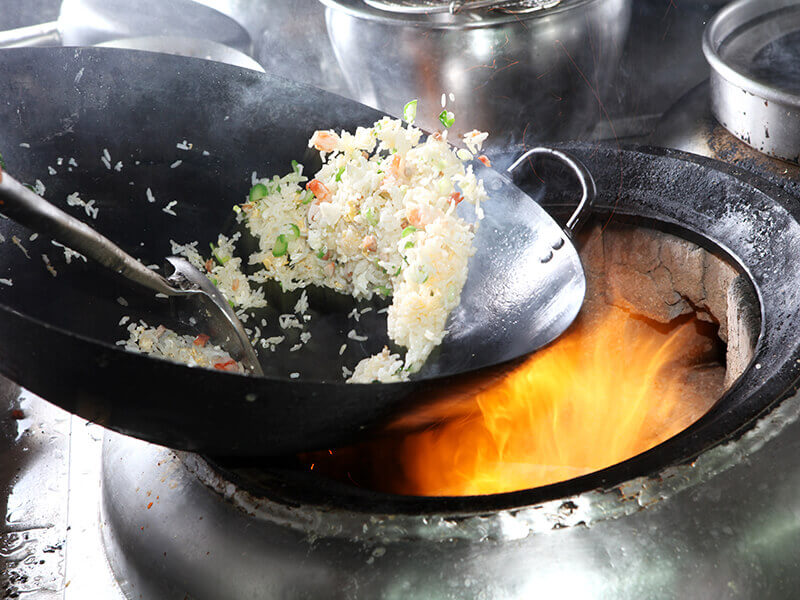
It’d be a mistake to talk about Chinese cooking methods without mentioning the wok (or kuo) – a deep cooking pot with a round-bottom (1). A premium wok made from carbon steel can be used for many Chinese cooking techniques but is definitely an irreplaceable cookware for stir-frying food.
The wok hei (also referred to as wok chi) or “the air of the wok” is a term used in Cantonese cooking. Simply put, wok hei is the flavor that can only be achieved by constantly stirring and tossing food over an open flame. This gives the food a smoky and unique flavor.
Stir-frying is one of the most commonly used cooking techniques in Chinese cuisine. By using this method, the chefs can integrate a variety of ingredients and spices into one frying pan; thus creating a perfect combination of mouth-watering flavors.
In addition to stir-frying, Chinese food can be deep-fry and pan-fry too. These two methods are often used to make food with a crispy outer layer but moist, tender inside.
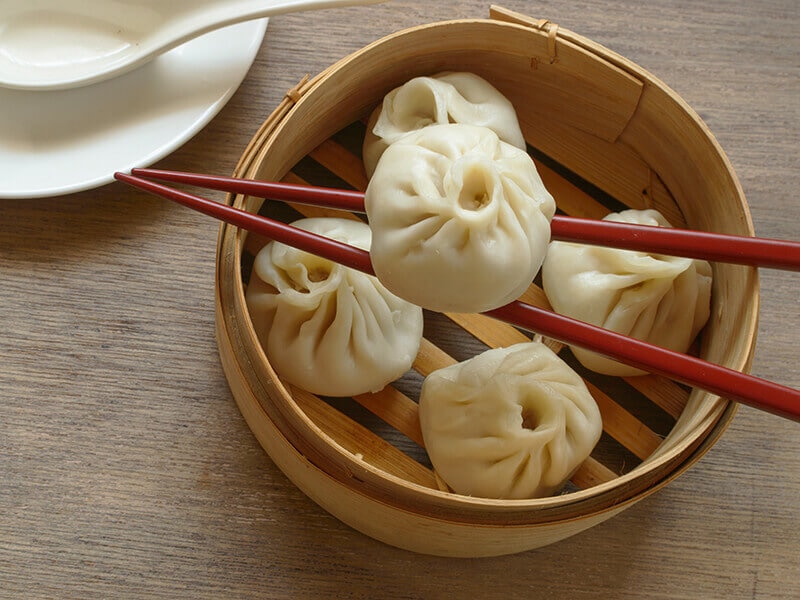
Steamed and boiled food also appears in Chinese cuisine. That’s why you’ll often come across top-notch bamboo steamers here. Usually prepared in these steamers, dumplings, buns, and . Xiaolongbao (small basket steamed dumplings) are a few of the well-loved steamed dishes here.
Chinese people also enjoy braised and roasted meals. While braising is used to create a texture so soft that it will melt in your mouth, roasting will give the food a beautifully charred outer layer.
Most Importantly, The Taste!
No matter how well-prepared and versatile the food is, the taste is what makes or breaks a good dish. Let’s dive right in this section to see if you are more “team Japan” or “team China”!
The Taste Of Japanese Food
Since Japanese food is deeply focused on keeping the original taste, they often avoid alternating the flavor too drastically. As a result, many Japanese meals have a light and pleasant taste to them – a kind of taste that can help soothe a tired mind and body.
Heavy emphasis on natural flavor also means that the ingredients, whether meats or vegetables, must be of high standards too. For this reason, food products from renowned brands (such as Kobe beef) are much higher in price and quality than unbranded ones.
The Japanese pair food with sauces too, especially with sushi or tempura – a Japanese dish served during first courses. Shoyu sauce – Japanese-style soy sauce, is also popular. However, they’ll only dip a very small part of the food into the sauce to avoid changing the original taste too much.
That said, dishes like yakisoba or gyudon can be quite flavorful too, though nothing too invasive. In general, Japanese food tends to avoid spicy flavor and more often leans on the sweet and umami side – a word for meaty, savory deliciousness in Japanese.
The Diverse Taste Of Chinese Cooking
As I’ve said earlier, China is a vast country, with each region boasting its own unique take on cooking style. However, many agree that classic Chinese dishes and their cooking style can be divided into 4 main groups, based on the eating habits of the people living in that region.
The first group is the Northern China group, which favors fresh and salty dishes with a lot of delicious braised and seafood recipes. The cuisine of Shandong province is a prime example of this cooking style.
People in Southern China also take great pride in their seafood. However, they prefer a lighter and sweeter taste. South China cooking is considered more refined and often appears in fine dining banquets. Guangdong, Jiangsu, and Zhejiang are great examples.
For people in Eastern China regions (such as Hunan, Gubei, or Sichuan), chili is an important ingredient as they like their food to be hot and spicy. If you’re a fan of spicy, stir-fried dishes, you will surely love the Easterners’ cooking style.
Western China provinces like Fujian and Anhui are famous for their use of wild, exotic animals in cooking. Their cooking also has a more sour and herbal taste to it, though some dishes can be sweet too. If you’re feeling adventurous, this is the style to go for.
Although incredibly diverse in taste and style, one thing that you will certainly notice when enjoying Chinese food is that it’s considerably more oily than Japanese cooking. You may like or dislike the grease, but know that it’s there to further elevate the flavor of the dish.
How About Something To Drink?
That’s a lot of information about the food, but let’s give the drinks some love too. Of course, there are many choices when it comes to drinks; however, I’ll only focus on these two countries’ traditional beverages in this section.
The Japanese are famous for their tea ceremony or sadou (The way of Tea), so it’s obvious that tea is an important traditional drink in Japan. For Japanese people, green tea is their tea of choice.
As for alcoholic beverages, Nihonshu (commonly called sake outside of Japan), Shochu, and Awamori are the three main types.
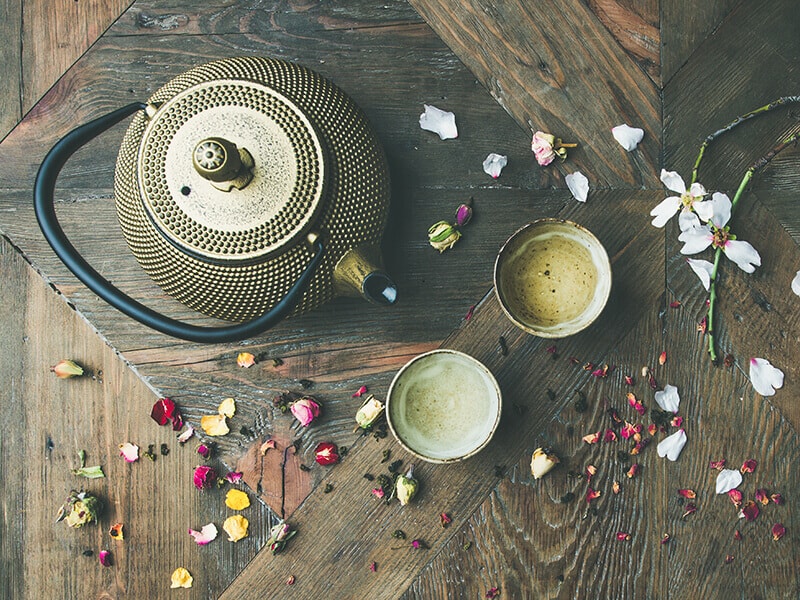
Chinese people also share a love for tea, though they prefer black tea (which is often stronger in flavor) over green tea.
China boasts a wider collection of alcoholic drinks than Japan, with each region having its own unique beverages. The most famous Chinese alcohol is definitely Baiju, and there are a lot of province-based varieties of this drink.
Other than that, Chhaang, Sanhuajiu, Shaoxing wine, and Xifengjiu are some other must-tries for Chinese alcohol beverage lovers.
The Philosophy Behind Food Decoration In Japan And China
Japan and China are both culturally rich countries, and this richness is undoubtedly reflected in how they decorate food.
The Use Of Color And Figure In Japanese Cuisine
In Japanese cuisine, it’s not only just about the food, it’s also about the visual presentation. When eating at a Japanese restaurant, especially a more traditional one, you will be surprised at how much attention and care was put into arranging a dish of sushi or sashimi.
Contrary to the symmetrical aesthetic that Western cuisines often aim for, Japanese food is presented in a more asymmetrical form. This is because Japanese food is meant to depict the unbalanced beauty of natural wonders such as mountains, rivers, and oceans.
Japanese food often comes in three, five, or seven servings, with five being the most common. This is to further embrace the asymmetrical theme and also represents the five essential flavors: savory, sweet, sour, salty, and bitter.
Furthermore, the presence of colors in food is another vital element that must be taken into consideration. Five key colors in a Japanese dish are: red, green, white, yellow, and black.
Not only do these colors play an important role in the overall presentation, but they are also an indication of a well-balanced, healthy dish.
Seasonality has an effect on how Japanese chefs decide to decorate their dish as well. Each season is associated with a certain set of colors that represent its natural characteristics. For example, spring in Japan is often related to the color pink – the color of cherry blossom.
Another art form that Japanese chefs have to master is “mukimono” – the art of carving food, mainly vegetables and fruits, into visually pleasing shapes. “Mukimono” serves as a way to add personality and excitement to a dish and has been practiced for thousands of years.
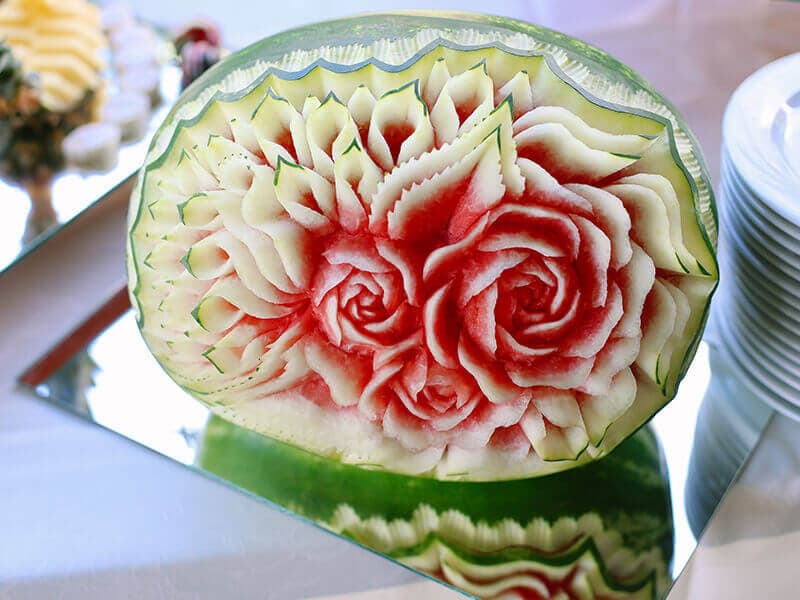
The Yin And Yang Philosophy Of Chinese Cooking
In the mind of Chinese people, every creation in the universe consists of two contrary but complementary and interconnected forces. Light and dark, water and fire, hot and cold, male and female are just a few easy-to-see examples of this great philosophy.
The principle of Yin and Yang has taken roots in Chinese culture for thousands of years, so it’s no surprise that it has been integrated into the cooking of this culturally rich country.
In Chinese cooking, food that is bright and warm in colors (red, yellow) with strong flavors (spicy or sweet) is considered yang element food. These foods are often grown or harvested on land. Land animals’ meat, chili, or potato are some great examples.
On the contrary, ingredients that are in green or cool colors and taste salty or bitter are categorized as yin food. These also include seafood and any ingredient that is grown in the water, such as soy sauce, lotus, and cucumber.
Similarly, cooking techniques that involve liquid elements such as steaming, boiling, or braising are called yin techniques. On the other hand, cooking methods that are oil-based or require fire elements such as frying, roasting are yang techniques.
In an ideal Chinese meal, the yin and yang elements have to be balanced. This principle is applied to both visual presentation and nutritional factors. In other words, if there is a meaty dish on the table, it must be either served or cooked with another vegetable-based dish.
Not only does yin and yang philosophy help the Chinese to create a healthy and balanced diet, but it also contributes to the eye-pleasing presentation of the meal.
Learn more about the yin and yang balance in food. Watch this video to know:
Chinese Food And Japanese Food, Which One Is Healthier?
Now you know that both Japanese and Chinese food are delicious and unique in their own ways. But which one of them is healthier? Well, this is a very good question.
Japanese cuisine favors fresh, raw ingredients and light cooking, which make Japanese food easier on the stomach and low in calories. For these reasons, Japanese cooking is generally considered healthy.
However, because raw fish is often used in Japanese traditional cooking, it might not be suitable for everyone.
The Chinese idea of cooking revolves around yin-yang philosophy, which is also a good way to make sure that the food is well-balanced in nutrition.
That said, Chinese chefs tend to use a great amount of oil in their cooking. This gives the food their sheen and makes them look more appetizing. However, greasy food is heavier in the stomach and higher in calories.
All in all, if I have to choose, I’d say Japanese cooking offers healthier options than its Chinese counterpart.
The Differences Between Japanese And Chinese Table Etiquette
Although both China and Japan use chopsticks as their main utensil, the proper table etiquette in these two countries is a little different from each other.
Japanese Table Etiquette
Japanese people begin their meals by saying “itakadimasu” which roughly translated to “to receive humbly”. When eating, you need to lift the rice bowl in a way that allows you to eat your rice neatly, but never too close to your mouth.
Japanese food is often served in individual proportions. However, it can also be served in family-style. If that’s the case, never touch the food directly with the tips of your chopsticks. Instead, turn the chopsticks around and use the top part to pick up food.
After the meal, remember to say gochisou-sama as a way to express your appreciation for the chef’s hard work.
Chinese Table Etiquette
Respecting the elders is one of the most basic rules in Chinese culture. Because of this, it’s a must to let your elders eat first. While eating, pick up your bowl and don’t bend down to bite food; Chinese people think of these actions as bad manners.
Unlike Japanese food, Chinese food is often placed in family-style. This means you should avoid turning or poking at the food as this will ruin the dish. It’s also a basic manner to close your mouth while chewing.
Use a handkerchief or leave the table when you need to sneeze or cough, no one wants your germs inside their food. Lastly, always say thank you after the meal.
Things That You Will Love (And Not Love) About These Two Cuisines
I believe that you have learned a great deal about these two countries’ cooking. To make things easier for you to decide the winner, here’s a table of things that people often love (or hate) about Japanese and Chinese food.
About Japanese Food
| Things to love | Things not to love |
| ● Fresh, raw ingredients ● A lot of delicious seafood ● Mild, soothing taste ● Not greasy means that you can eat more ● Elaborate presentation ● Low in calories and healthy | ● Lack of hot, spicy dishes ● Lack of meat varieties (if you’re into exotic meals) ● Lack of “interesting” cooking methods ● Some people might not like raw fish |
About Chinese Food
| Things to love | Things not to love |
| ● Diverse in taste and cooking techniques ● Strong tasting, flavorful dishes ● Diverse in meat choices ● Colorful and yin-yang balanced ● Often well-cooked | ● Might be too greasy for some ● High in calories and can sometimes be unhealthy |
FAQs
Still have more questions regarding Chinese and Japanese food? Check to see if the answers to your questions are in this section!
So What Will It Be, Japanese Or Chinese Food?
With all this information, you surely have made up your mind about the winner, right? Ok, maybe not. But don’t worry, you and I are not the only ones struggling to find the better one between these two cuisine giants. So, how about enjoying both of them?
I hope you enjoyed reading this article. If you think that this post is helpful, give it a like and share it around! Also, tell me in the comments which one you think is more tasty, Chinese or Japanese food.
References
- Contributors to Wikimedia projects, (2001). Wok – Wikipedia [online]. Wikipedia, the free encyclopedia. Available from: <https://en.wikipedia.org/wiki/Wok>
- Why do people living in hot climates like their food spicy? [online]. (no date). PubMed Central (PMC). Available from: <https://www.ncbi.nlm.nih.gov/pmc/articles/PMC4861189/>


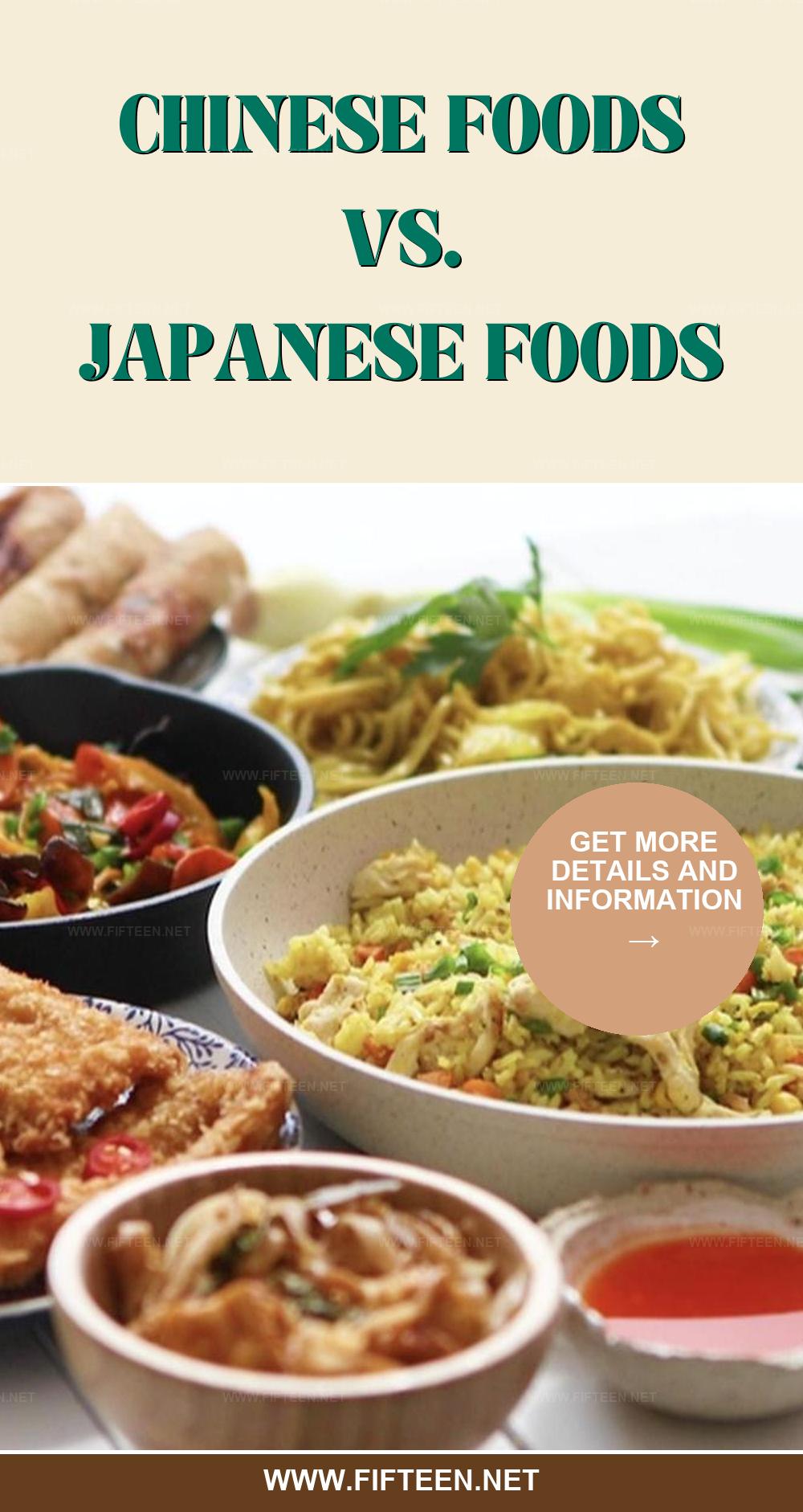
Jamie Scott
Editor in Chief, Senior Content Writer
Expertise
Home Cooking, Meal Planning, Recipe Development, Baking and Pastry, Food Editor, Cooking-video Maker, Western Food Evaluation Expert
Education
Le Cordon Bleu College of Culinary Arts
Local Community College, New York, NY
Jamie Scott is a skilled culinary expert and content creator specializing in Western cuisine. With over 15 years in the culinary field and formal training from Le Cordon Bleu, Paris, Jamie deeply understands how to blend nutrition with delicious flavors. His passion for cooking matches his commitment to making healthy eating accessible and enjoyable.
On Fifteen.net, Jamie brings a fresh perspective to classic dishes and beverages, offering readers insightful recipes, cooking tips, and a fresh view on meal planning that emphasizes taste, health, and simplicity.